Sabrent Rocket Q4 and Corsair MP600 CORE NVMe SSDs Reviewed: PCIe 4.0 with QLC
by Billy Tallis on April 9, 2021 12:45 PM ESTMixed IO Performance
For details on our mixed IO tests, please see the overview of our 2021 Consumer SSD Benchmark Suite.
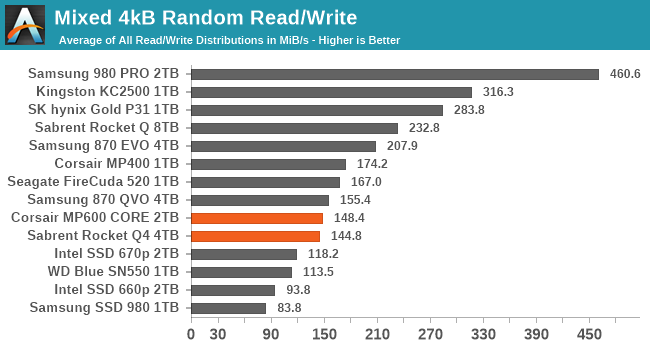 |
|||||||||
| Mixed Random IO | Throughput | Power | Efficiency | ||||||
| Mixed Sequential IO | Throughput | Power | Efficiency | ||||||
The Sabrent Rocket Q4 and Corsair MP600 CORE deliver excellent performance on the mixed sequential IO test, leading to above-average power efficiency as well. Their performance on the mixed random IO test is not great, and is actually slower overall than what we saw with Phison E12 QLC drives like the original Rocket Q and the MP400.
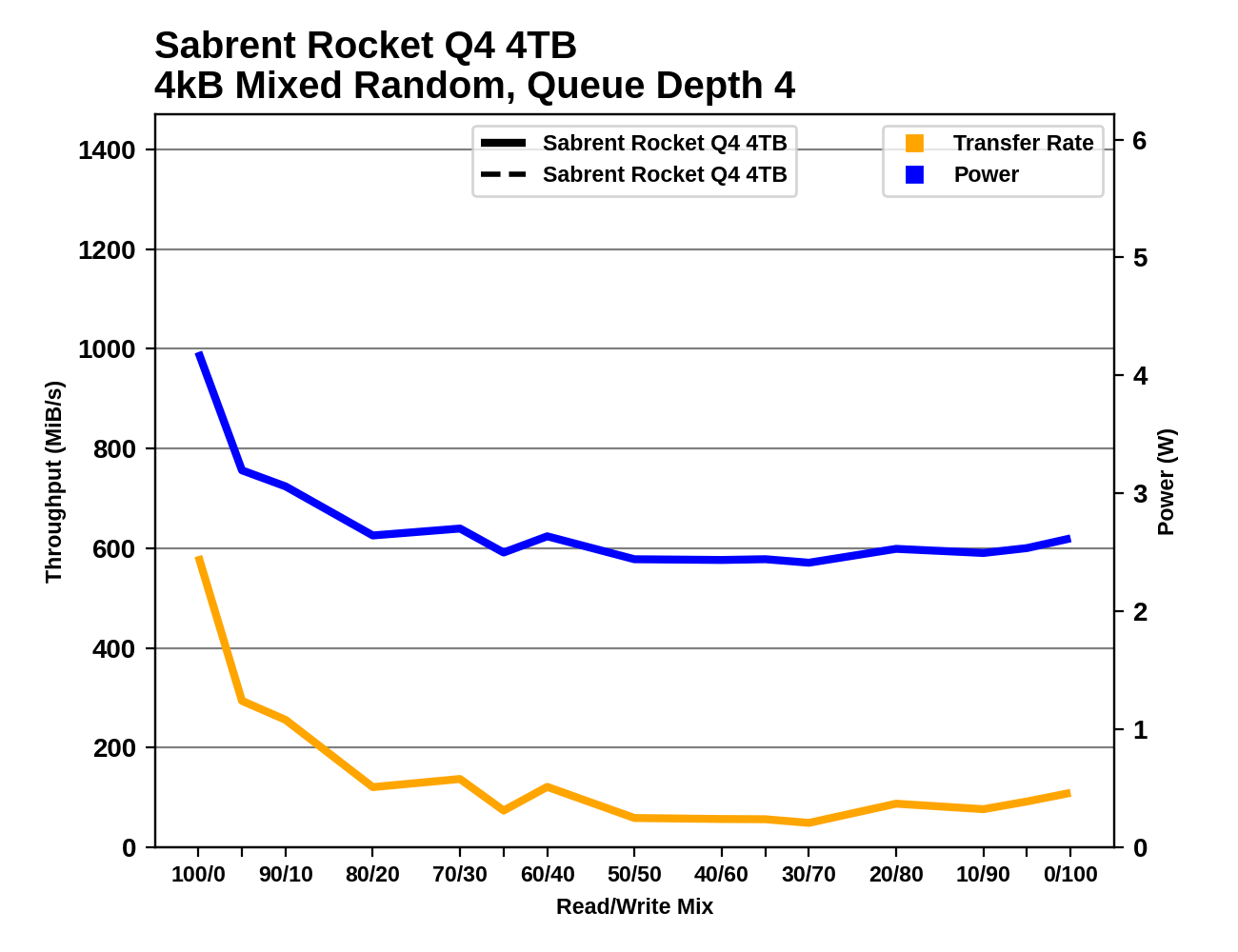 |
|||||||||
| Mixed Random IO | |||||||||
| Mixed Sequential IO | |||||||||
The earlier E12+QLC drives outperform these new E16+QLC drives across almost all phases of the mixed random IO test, despite using same Micron 96L QLC NAND. On the other hand, the newer QLC drives turn in surprisingly fast and steady results throughout the mixed sequential IO test, though the 2TB MP600 CORE does get off to a bit of a slow start.
Power Management Features
Real-world client storage workloads leave SSDs idle most of the time, so the active power measurements presented earlier in this review only account for a small part of what determines a drive's suitability for battery-powered use. Especially under light use, the power efficiency of a SSD is determined mostly be how well it can save power when idle.
For many NVMe SSDs, the closely related matter of thermal management can also be important. M.2 SSDs can concentrate a lot of power in a very small space. They may also be used in locations with high ambient temperatures and poor cooling, such as tucked under a GPU on a desktop motherboard, or in a poorly-ventilated notebook.
| Sabrent Rocket Q4 4TB NVMe Power and Thermal Management Features |
|||
| Controller | Phison E16 | ||
| Firmware | RKT40Q.2 (EGFM52.3) | ||
| NVMe Version |
Feature | Status | |
| 1.0 | Number of operational (active) power states | 3 | |
| 1.1 | Number of non-operational (idle) power states | 2 | |
| Autonomous Power State Transition (APST) | Supported | ||
| 1.2 | Warning Temperature | 75 °C | |
| Critical Temperature | 80 °C | ||
| 1.3 | Host Controlled Thermal Management | Supported | |
| Non-Operational Power State Permissive Mode | Supported | ||
Our samples of the Sabrent Rocket Q4 and Corsair MP600 CORE use the same firmware from Phison (though Sabrent has re-branded the version numbering). As a result, they support the same full range of power management features. The 4TB Rocket Q4 reports higher maximum power draws for its active power states than the 2TB MP600 CORE, but both drives report the same idle behaviors.
The advertised maximum of 10.58 W for the 4TB Rocket Q4 is alarming and definitely supports Sabrent's suggestion that the drive not be used without a heatsink. However, during our testing the drive never went much above 7W for sustained power draw, which is more in line with the maximum power claimed by the 2TB MP600 CORE (which also tended to stay well below its supposed maximum). In practice, these drives can get by just fine without a big heatsink as long as they have some decent airflow, because real-world workloads will almost never push these drives to their maximum power levels for long.
| Sabrent Rocket Q4 4TB NVMe Power States |
|||||
| Controller | Phison E16 | ||||
| Firmware | RKT40Q.2 (EGFM52.3) | ||||
| Power State |
Maximum Power |
Active/Idle | Entry Latency |
Exit Latency |
|
| PS 0 | 10.58 W | Active | - | - | |
| PS 1 | 7.14 W | Active | - | - | |
| PS 2 | 5.43 W | Active | - | - | |
| PS 3 | 49 mW | Idle | 2 ms | 2 ms | |
| PS 4 | 1.8 mW | Idle | 25 ms | 25 ms | |
Note that the above tables reflect only the information provided by the drive to the OS. The power and latency numbers are often very conservative estimates, but they are what the OS uses to determine which idle states to use and how long to wait before dropping to a deeper idle state.
Idle Power Measurement
SATA SSDs are tested with SATA link power management disabled to measure their active idle power draw, and with it enabled for the deeper idle power consumption score and the idle wake-up latency test. Our testbed, like any ordinary desktop system, cannot trigger the deepest DevSleep idle state.
Idle power management for NVMe SSDs is far more complicated than for SATA SSDs. NVMe SSDs can support several different idle power states, and through the Autonomous Power State Transition (APST) feature the operating system can set a drive's policy for when to drop down to a lower power state. There is typically a tradeoff in that lower-power states take longer to enter and wake up from, so the choice about what power states to use may differ for desktop and notebooks, and depending on which NVMe driver is in use. Additionally, there are multiple degrees of PCIe link power savings possible through Active State Power Management (APSM).
We report three idle power measurements. Active idle is representative of a typical desktop, where none of the advanced PCIe link or NVMe power saving features are enabled and the drive is immediately ready to process new commands. Our Desktop Idle number represents what can usually be expected from a desktop system that is configured to enable SATA link power management, PCIe ASPM and NVMe APST, but where the lowest PCIe L1.2 link power states are not available. The Laptop Idle number represents the maximum power savings possible with all the NVMe and PCIe power management features in use—usually the default for a battery-powered system but rarely achievable on a desktop even after changing BIOS and OS settings. Since we don't have a way to enable SATA DevSleep on any of our testbeds, SATA drives are omitted from the Laptop Idle charts.
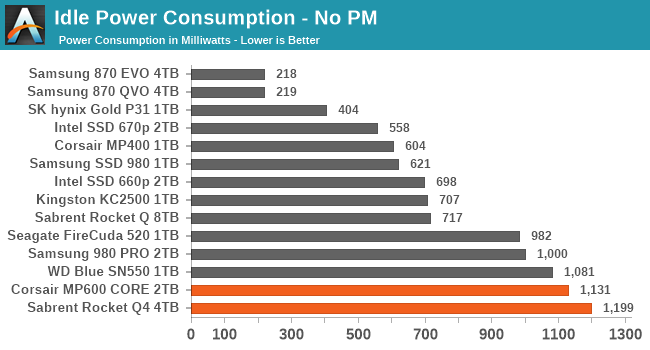
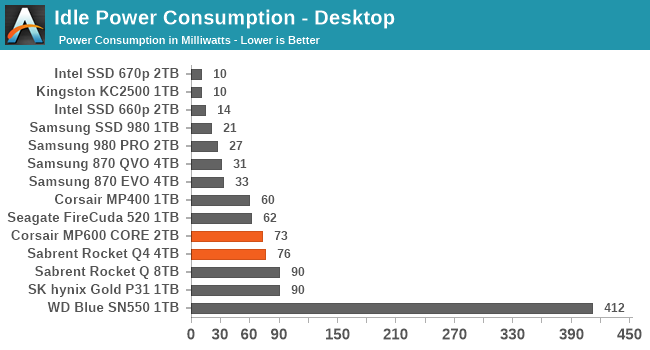
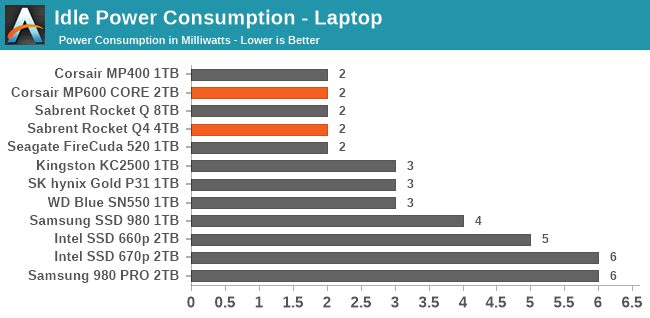
Both the Sabrent Rocket Q4 and Corsair MP600 CORE show quite high active idle power draw, a consequence of their use of a PCIe Gen4 controller made on 28nm rather than something newer like 12nm. However, there's no problem with the low-power idle states except for Phison's usual sluggish wake-up from the deepest sleep. This seems to be worse for higher capacity drives, with the 4TB Rocket Q4 taking about an eighth of a second to wake up.
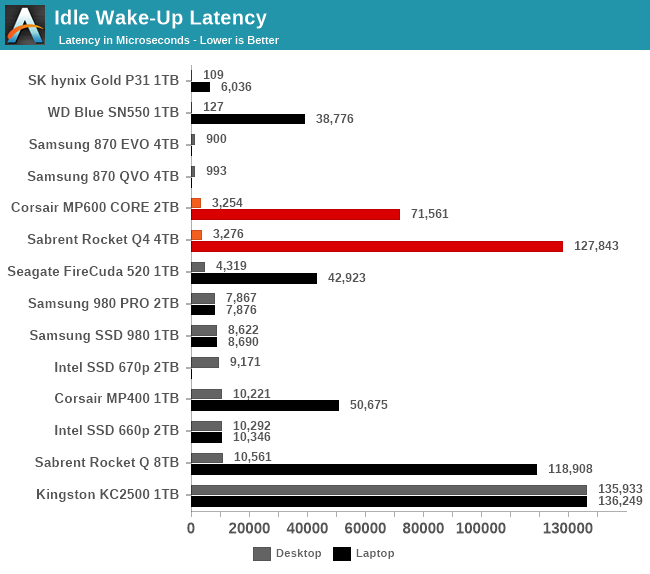










60 Comments
View All Comments
ZolaIII - Friday, April 9, 2021 - link
What's the purpose of those? I mean I recently bought MP600 1 TB for the price of MP600 Core same capacity. I didn't bought it for it's speed but it's TBW endurance which is by the way twice as MP600 Core 4GB.This doesn't have any market place in my opinion when you can buy a drive with same controller and same 96 layer but TCL NAND for a same price or just a little bit more money.
SarahKerrigan - Friday, April 9, 2021 - link
Yeah, right now really the only sweet spot for QLC is at 4TB.powerarmour - Saturday, April 10, 2021 - link
Absolutely, enough with this anti-consumer QLC junk. There needs to be a better tech solution that doesn't trade performance for density's sake, a better balance would be more ideal.Oxford Guy - Sunday, April 11, 2021 - link
'that doesn't trade performance for density's sake'Performance, value (by harming TLC's economy of scale), and longevity.
30% density increase for twice as many voltage states is not a great bargain.
ballsystemlord - Saturday, April 10, 2021 - link
A pig with lipstick on is still a pig. QLC is currently a pig.It ->still<- has huge leaps and bounds to go for before it becomes a viable SSD storage medium.
Oxford Guy - Sunday, April 11, 2021 - link
There are no leaps and bounds for it.The one thing that made TLC good enough was the transition from planar to 3D manufacturing.
QLC has no such saving grace in store – that's my bet.
arashi - Sunday, April 11, 2021 - link
4D manufacturing /s0ldman79 - Saturday, April 17, 2021 - link
With enough channels QLC and 4TB+ drives could work.SLC cache, QLC long term storage and 8-16 channels, that could work.
Honestly for longevity and performance I'm not sure QLC is going to beat out TLC unless they get QLC up to TLC's endurance and speed, which is likely not financially viable even if technically possible.
GeoffreyA - Sunday, April 11, 2021 - link
They're trying to pull the wool over people's eyes and sell margarine at the price of butter, hoping nobody notices.dickeywang - Sunday, April 11, 2021 - link
Unfortunately, the market isn't driven by consumers who can tell the difference between QLC and TLC. Most of the time, consumers just want to have larger capacity with lower prices. If it is the garbage they want, it is what they get. That's the sad story of capitalism.